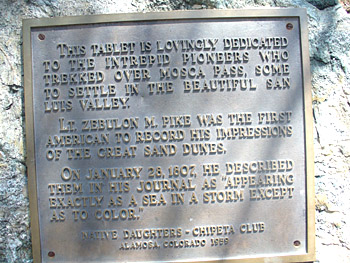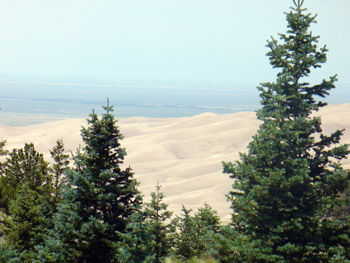|
Brass
plaques abound. Free standing or more often embedded in some structure
even more permanent, such as a basalt boulder or a twenty-story steel
and granite building, plaques serve a rhetorical not an architectural
purpose. Their military colors, sharp edges, and upper-case hieratic
fonts make two pronouncements about the site or the building: appropriation
and origination. They shout that this place belongs to X because X did
Y first. A brass commemorative plaque is the metallic equivalent of
the planting of a flag. It is not surprising that in terms of truth-statements
plaques are often tissue thin.
In
January of 1807 Zebulon Pike and ten men crossed the Sangre de Cristo
Mountains from east to west, probably using what today is called the
Medano Pass west of Pueblo, Colorado. As he notes in his journal, coming
down the west side of the mountains they saw the Great Sand Dunes, which
pile up against the mountains on the eastern edge of the San Luis Valley
(the photograph captures something like the view). It was a picturesque
moment in the middle of a disastrous expedition, sandwiched between
failing to discover the headwaters of the Red and the Arkansas rivers,
trekking in circles through the wintry Colorado Rockies, unsuccessfully
attempting to climb what we today call Pike's Peak, leaving exhausted
men without food behind in the snow, and being captured by the Mexican
military and sent under guard to Chihuahua and eventually turned over
to U. S. authorities in Natchitoches.
None
of this is mentioned by the Chipeta Club of the Native Daughters of
Alamosa, Colorado, who commissioned the plaque pictured above. It stands
at the western head of a trail that follows Mosca Creek from the Great
Sand Dunes up to the top of Mosca Pass--which Zebulon Pike probably
did not travel. It also sanctifies Pike as "the first American
to record his impressions of the Great Sand Dunes." This is a blatant
act of appropriation and origination. It disregards, for instance, other
Americans--native Americans--who had in their own rhetorical ways recorded
their impressions of the Great Sand Dunes for centuries before Pike
and his companions saw them in 1807. The Utes called the Dunes sowapophe-uvehe,
"the land that moves back and forth," and the Jicarilla Apaches
called them ei-anyedi, "it goes up and down." Also
the Spanish had been exploring, trading, and settling in the San Luis
Valley since 1692, giving them a century of opportunities before Pike
to record their impressions of the Great Sand Dunes, which are visible
from any part of the Valley on a clear day. The only reasonable claim
to origination with Pike's journal entry is if we read "first American"
to mean "first Anglo U. S. citizen" and "record"
to mean "inscribe in English on paper that has survived and is
known to historians." Even that claim could easily be untrue.
Indeed,
it is a claim that probably will not survive as long as the brass plaque
planted at the foot of Mosca Canyon by the Native Daughters of Alamosa.
For a delightful exposé of the inaccuracies perpetuated in commemorative
sites in the USA, see James W. Loewen Lies Across America: What
Our Historic Sites Get Wrong (New York: New Press, 1999). The Indian
names for the Great Sand Dunes I found in the National
Parks website. Incidentally, Pike's entry reads, "Their appearance
was exactly that of a sea in a storm, except as to color," which
the plaque slightly misquotes.
RH,
August 2008
|

